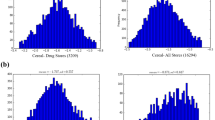Abstract
We revisit and test Salop and Stiglitz (1982) Theory of Sales. Equilibrium comparative static predictions are that greater consumer storage constraints lead to: (1) higher average prices, (2) fewer promotions, and (3) shallower promotions. In equilibrium, price dispersion is nonlinear in storage constraints, first increasing then decreasing. Empirical estimates of storage constraints are developed for approximately 1,000 households using the American Housing Survey (1989), United States Census (1990), and Stanford Market Basket Database (1991–1993). We find consumers with greater storage constraints shop more often and purchase smaller quantities per visit; moreover, the comparative static predictions are supported and evidence consistent with the equilibrium dispersion prediction is observed. Estimated quantitative effects are economically important.
Similar content being viewed by others
References
Alba, J. W., Broniarczyk, S. M., Shimp, T. A., & Urbany, J. E. (1994). The Influence of Prior Beliefs, Frequency Cues, and Magnitude Cues on Consumers’ Perceptions of Comparative Price Data. Journal of Consumer Research, 21, 219–235.
Assuncao, J., & Meyer, J. R. (1993). The Rational Effect of Price Promotions on Sales and Consumption. Management Science, 5, 517–535.
Bell, D. R., Chiang J., & Padmanabhan, V. (1999). The Decomposition of Promotional Response: An empirical generalization. Marketing Science, 18, 504–526.
Bell, D. R., Iyer, G., & Padmanabhan, V. (2002). Price Competition Under Stockpiling and Flexible Consumption. Journal of Marketing Research, 39, 292–303.
Bell, D.R., Ho, T-H., & Tang, C. S. (1998). Determining where to shop: Fixed and Variable Costs of Shopping. Journal of Marketing Research, 35, 352–369.
Blattberg, R.C., Eppen, G. D., & Lieberman, J. (1981). A Theoretical and Empirical Evaluation of Price Deals for Consumer Non-durables. Journal of Marketing, 45, 116–129.
Bucklin, R.E., & Gupta, S. (1992). Brand Choice, Purchase Incidence and Segmentation: An Integrated Modeling Approach. Journal of Marketing Research, 29, 201–215.
Bucklin, R.E., Gupta, S., & Siddarth, S. (1998). Determining Segmentation in Sales Response Across Purchase Behaviors. Journal of Marketing Research, 35, 189–197.
Bucklin, R. E., & Lattin, J. M. (1992). A Model of Product Category Competition Among Grocery Retailers. Journal of Retailing, 68, 271–293.
Chiang, J. (1991). A Simultaneous Approach to the Whether, When and How Much to Buy Questions. Marketing Science, 10, 297–315.
Chintagunta, P. K. (1993). Investigating Brand Choice, Purchase Incidence and Purchase Quantity Decisions of Households. Marketing Science, 12, 184–208.
Eppen, G. D., & Lieberman, Y. (1984). Why Do Retailers Deal? An Inventory Explanation. Journal of Business, 57, 519–530.
Glaeser, E. L., Gyourko, J., & Hilber, C.A.L. (2001). Housing affordability and land prices: Is there a crisis in American cities? Mimeo: The Wharton School, University of Pennsylvania.
Glaeser, E. L., & Gyourko, J. (2005). Urban Decline and Durable Housing. Journal of Political Economy, 113, 345–375.
Glaeser, E.L., & Gyourko, J. (2003). The Impact of Zoning on Housing Affordability. Economic Policy Review, 9, 21–30, Federal Reserve Bank of New York.
Gupta, S. (1988). Impact of Sales Promotions on When, What, and How Much to Buy. Journal of Marketing Research, 25, 342–355.
Hendel, I., & Nevo, A. (2003). Measuring the implications of sales and consumer stockpiling behavior. Mimeo: University of California, Berkeley.
Hendel, I., & Nevo, A. (2004). Sales and Consumer Inventory, NBER Working Paper 9048.
Jeuland, A.P., & Narasimhan, C. (1985). Dealing–-Temporary price cuts–-by Seller as a Buyer Discrimination Mechanism. Journal of Business, 58, 295–308.
Kahneman, D., & Tversky, A. (1979). Prospect theory: An Analysis of Decision under Risk. Econometrica, 47, 263–291.
Krishna, A. (1992). The Normative Impact of Consumer Price Expectations for Multiple Purchase Brands on Consumer Purchase Behavior. Marketing Science, 11, 266–286.
Krishnamurthi, L., Mazumdar, T., & Raj, S. P. (1992). Asymmetric Response to Price and Consumer Brand Choice and Purchase Quantity Decisions. Journal of Consumer Research, 19, 387–400.
Lach, S. (2002). Existence and Persistence of Price Dispersion: An empirical analysis. Review of Economics and Statistics, 84, 433–445.
Meyer, R.J., & Assuncao, J. (1990). The Optimality of Consumer Stockpiling Strategies. Marketing Science, 9, 18–41.
Montgomery, A. L. (1997). Creating Micro-Marketing Pricing Strategies Using Supermarket Scanner Data. Marketing Science, 16, 315–337.
Narasimhan, C. (1984). A Price Discrimination Theory of Coupons. Marketing Science, 3, 128–147.
Narasimhan, C. (1988). Competitive promotional strategies. The Journal of Business, 61, 427–449.
Pauwels, K., Hanssens, D. M., & Siddarth, S. (2002). The Long Term Effects of Pricing and Promotions on Category Traffic, Brand Choice and Purchase Quantity. Journal of Marketing Research, 39, 421–439.
Raju, J.S., Srinivasan, V., & Lal, R. (1990). The Effects of Brand Loyalty on Competitive Price Promotional Strategies. Management Science, 36, 427–449.
Salop, S., & Stiglitz, J.E. (1982). The Theory of Sales: A Simple Model of Equilibrium Price Dispersion with Identical Agents. American Economic Review, 72, 1121–1130.
Simester, D. I. (1995). Signaling Price Image Using Advertised Prices. Marketing Science, 14, 166–188.
Sorenson, A. T. (2000). Equilibrium Price Dispersion in Retail Markets for Prescription Drugs. Journal of Political Economy, 108, 833–850.
Stigler, J. (1961). The Economics of Information. Journal of Political Economy, 69, 213–225.
van Heerde, H.J., Leeflang P. S. H., & Wittink, D.R. (2000). The Estimation of Pre- and Postpromotion Dips with Store-Level Scanner Data. Journal of Marketing Research, 37, 383–395.
van Heerde, H.J., Gupta, S., & Wittink, D. R. (2003). Is 75% of the Sales Promotion Bump due to Brand Switching? No, Only 33% Is. Journal of Marketing Research, 40, 481–491.
Varian, H. R. (1980). A Model of Sales. American Economic Review, 70, 651–659.
Author information
Authors and Affiliations
Corresponding author
Additional information
JEL Classification D12 · D40 · M3
Rights and permissions
About this article
Cite this article
Bell, D.R., Hilber, C.A.L. An empirical test of the Theory of Sales: Do household storage constraints affect consumer and store behavior?. Quant Market Econ 4, 87–117 (2006). https://doi.org/10.1007/s11129-006-8127-9
Issue Date:
DOI: https://doi.org/10.1007/s11129-006-8127-9




